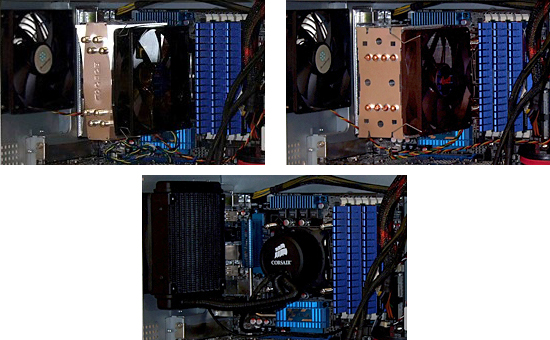Small Water Versus Big Air, Part 3: Cooling Questions Answered
The Equalizer(s)
Our quest to find an advantage—any advantage—in today’s maintenance-free compact liquid coolers began with CoolIT’s Domino A.L.C. sealed liquid system and the low-cost Cogage True Spirit 120mm tower. Unfortunately, the liquid cooler only performed as well as the air cooler when its custom-wired fan was forced to operate at its maximum speed of 2,800 RPM, versus the air cooler’s maximum fan speed of 1,600 RPM. The enormous increase in cost and noise for sub-par cooling performance put the Domino A.L.C. at an equally big disadvantage compared to the simpler sink and fan.
Our quest continued with Corsair’s H50 sealed-liquid system and Rosewill’s FORT120 air-cooling tower, where the air cooler’s fast 2,400 RPM fan gave it a cooling advantage comparable to its resulting acoustic disadvantage. Readers complained that the tradeoff between cooling and noise could only be addressed by using the same fan on both coolers, while Corsair pointed out that we weren't using the configuration the way it was designed, blowing cooler air through the radiator. In contrast, air coolers must typically use warm case air to cool the processor, which is a disadvantage not properly reflected on an open bench. End users typically don’t run open systems, and the H50 was designed to use the case advantageously.
This leaves us with a few additional configurations to test. How much better will the Corsair H50 and the Cogage True Spirit function with Rosewill’s FORT120 more powerful fan? How much worse will the Cogage True Spirit and Rosewill FORT120 perform in a closed system? Today we test each configuration inside a traditional oversized mid-tower case, using two different fan configurations for each unit.
Get ready. All of your questions are about to be answered.
Get Tom's Hardware's best news and in-depth reviews, straight to your inbox.
-
Annisman Ditched my Domino A.L.C. for a Xigmatek Thor's Hammer with 2 X Scythe fans. Strapped it on a Core i7 920, bumped it to 4.0Ghz and never looked back.Reply -
burnley14 Interesting. This is good to know for a future build, since cheap water cooling was always a temptation for me.Reply -
tkgclimb I was looking at water, then I decided if I really want to do this I'm going to have to spend at least 200 if i want a good, effective, upgradeable system. So I'm going to get the megahalem or the thermalright TRUE extreme. and stay with some sick air.Reply -
rpmrush Air is still a better value unless you value noise or lack there of.Reply
Water offers lower noise @ a slightly less extreme overclock, but who runs 4.0Ghz plus everyday. -
apache_lives still using my old thermaltake big typhoon with a few mods - sealed the gaps on the sides for more air pressure and using a 12cm "thick" fan from a dell tower (crazy) and the same type fan to extract air - works a treat :DReply
kinda proves that when your going water cooling, do it PROPERLY not a pre made kit
if i was to do water cooling, i would go all the way with a modded car radiator, drum for a water sump and a few powerful decent sized pumps to start off with to keep everything sweet, none of this "barely better then stock" bs. -
The corsair h50 is NOT a water cooling solution. Not even close. At best, call it an "optimized" air cooler. The only situation where you would want one is if you need to install a cooler in a tight space. Otherwise, it's higher cost really ruins any value it has.Reply
-
The_Blood_Raven Get a Swiftech H220 in there and it will beat the air coolers pretty well, besides that there are no out of the box water cooling setups that can actually beat high end air coolers by anything meaningful.Reply
Good article though, your best articles are when you take the time to answer these odd questions that are commonly asked by the enthusiast. -
Onus As many times as I see bottom-PSU cases like the Antec 300 recommended in builds in the Forum, the lingering question for me becomes, "Suppose I do have a bottom-psu top-panel-fan case. Would that make a difference?" Or, is there ANY situation where the cooling performance of this type of liquid cooler is actually superior to a big air cooler?Reply -
skora Thanks for listening to the feedback and doing follow ups like this TS. Really gives the community a reason to become involved knowing our unanswered questions get addressed.Reply

